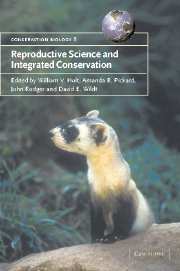Book contents
- Frontmatter
- Contents
- List of contributors
- Foreword
- Part I Introduction
- Part II Reproduction and population viability
- Part III Reproductive techniques for conservation management
- 9 Reproductive and welfare monitoring for the management of ex situ populations
- 10 Non-invasive endocrine measures of reproduction and stress in wild populations
- 11 Ultrasound for analysis of reproductive function in wildlife species
- 12 Role of embryo technologies in genetic management and conservation of wildlife
- 13 Application of nuclear transfer technology to wildlife species
- Part IV Integrated conservation management
- Part V Reproduction science in non-mammalian species
- Part VI Conclusions
- Index
- References
11 - Ultrasound for analysis of reproductive function in wildlife species
Published online by Cambridge University Press: 21 January 2010
- Frontmatter
- Contents
- List of contributors
- Foreword
- Part I Introduction
- Part II Reproduction and population viability
- Part III Reproductive techniques for conservation management
- 9 Reproductive and welfare monitoring for the management of ex situ populations
- 10 Non-invasive endocrine measures of reproduction and stress in wild populations
- 11 Ultrasound for analysis of reproductive function in wildlife species
- 12 Role of embryo technologies in genetic management and conservation of wildlife
- 13 Application of nuclear transfer technology to wildlife species
- Part IV Integrated conservation management
- Part V Reproduction science in non-mammalian species
- Part VI Conclusions
- Index
- References
Summary
INTRODUCTION AND OBJECTIVES
Ultrasonography was used as early as the 1950s to characterise soft tissues in humans, and today is used routinely in human and veterinary medicine in the areas of ophthalmology, cardiology, neurology, nephrology, gynaecology and andrology, obstetrics, organ transplantation, oncology, orthopaedics and dermatology. It is somewhat surprising then that ultrasonography has received so little attention in zoo and wildlife medicine (see review, Hildebrandt & Göritz, 1998). Furthermore, although the number of investigations has increased recently, the focus remains on mammals (69%) with less emphasis on reptiles (19%), birds (12%), fish and amphibians (<1%) (Göritz, 1996).
Reproduction in many zoo-held animals is poor, and infertility caused by physiological disorders or mismanagement prohibits creating selfsustaining populations. Because of limited knowledge of species' reproductive anatomy and physiology, techniques to determine sex, sexual maturity, reproductive tract morphology, the reproductive cycle itself and gestation and foetal growth are critical to successful ex situ reproduction and management. This is an exciting time because ultrasonography is finally finding a niche in the study and management of rare wildlife species. Since 1993 we have conducted thousands of ultrasound examinations in more than 100 species, often in collaboration with reproductive biologists, theriogenologists and pathologists. The aim of this chapter is to describe some of our experiences in the use of ultrasonography as a powerful tool for assessing reproductive fitness of captive and free-living wildlife species.
- Type
- Chapter
- Information
- Reproductive Science and Integrated Conservation , pp. 166 - 182Publisher: Cambridge University PressPrint publication year: 2002
References
- 2
- Cited by



